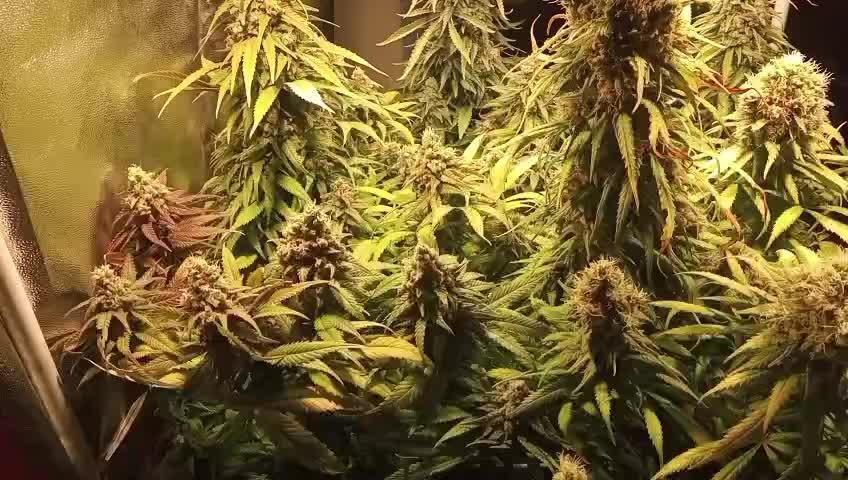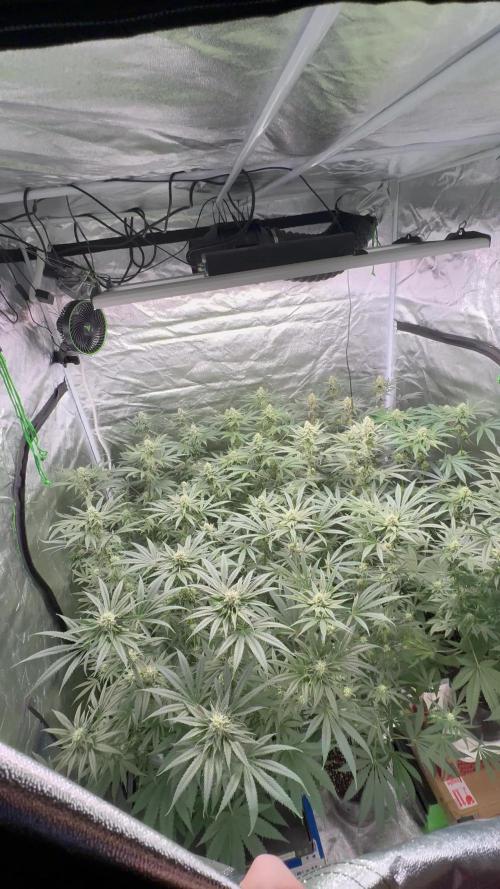The Grow Awards 2026 🏆 





































Likes
Comments
Share


@RDWCGrowing
Follow
4/6/2024 - Vegetation Week 8 Day 1- Last week in VEG, They are all looking amazing and no worry about stretch when I flip Next Saturday they are indica and I have more than 50% of distance from the top of the plant to the lights with a little more I can raise the lights if necessary. So going to really just enjoy this last week of VEG, and get my Cloning equipment ready. I will be taking 2 cuts for each this is also a PHENO hunt for HWG and he not only has the prize for the winner but he also has an additional bounty on a cut of the winner. I did have to take some from around the edges to keep them from touching.
4/7/2024 - Vegetation Week 8 Day 2- Didn't do anything today but watch them grow.. They will be getting a really good flip trim and clean up for clone material on Friday/ Saturday.
4/8/2024 - Vegetation Week 8 Day 3- Couldn't even get a picture of the #1 at first too much Foliage throughout.. So I had to clean that up and make sure they all still have some separation before flip.
4/9/2024 - Vegetation Week 8 Day 4- Huston we almost had an issue.. I looked at my Res and she was in desperate need of 10 gallons to get her through until next water change on Saturday. So I added 10 gallons and the Nutes.
I added 10 Gallons of Water
I added the following Nutes:
CalMag= 1.00Mil/Gal= 10Mil
FloraMicro = 5.4Mil/Gal= 54Mil
FloraGro= 4.2Mil/Gal= 42Mil
FLoraBloom= 4.6Mil/Gal= 46Mil
4/10/2024 - Vegetation Week 8 Day 5- Had to giver them a huge clean up today I couldn't even see the numbers in the first pic. I am also worried that #1 and #3 really, really are getting huge over the last few days.. starting to think I should have flipped them this past Saturday.. The interesting things is even though this is an Indica Strain, I might have to super crop just to keep them off the lights.
The joys and sorrows of RDWC and timing.
4/11/2024 - Vegetation Week 8 Day 6- Even though Flipping in Two days almost wish I would have gone at Week 7. I am really worried about #3, #1 and #2 are huge and when I put them in flower they are going to stretch out
4/12/2024 - Vegetation Week 8 Day 7- Day of Work.. Lots of Work.. I gave all three a Cloning/Flower cleaning.. all three got cleaned up top Inside and bottom, I took 2 cuts of each to see which one come out on top then I will kill off the other cuts once I have a winner in flower. I clean up this thoroughly before I flip because it reduces the work load on the next major clean up I do on Week 4 of Flower.and they are so much taller that it is going to be a pain in the ass to maintain canopy space for #3, we will see how it goes and adjust as necessary..
Likes
19
Share


@KeiKie90
Follow
1.10.2021 Day 8
Crystal METH
Info:
Nutrients: n/a
Water: 300ml
Temperature: 21*C - 29*C
Humidity: 54% - 72%
2.10.2021 Day 9
Crystal METH
Info:
Nutrients: n/a
Water: 300ml
Temperature: 22*C - 29*C
Humidity: 52% - 72%
3.10.2021 Day 10
Crystal METH
Info:
Nutrients: n/a
Water: 300ml
Temperature: 21*C - 29*C
Humidity: 56% -78%
4.10.2021 Day 11
Crystal METH
Info:
Nutrients: 2nd week!
Water:
Temperature: 21*C - 27*C
Humidity: 54% - 76%
5.10.2021 Day 12
Crystal METH
Info:
Nutrients: n/a
Water: 300ml
Temperature: 22*C - 29*C
Humidity: 50% - 68%
6.10.2021 Day 13
Crystal METH
Info:
Nutrients: n/a
Water: 300ml
Temperature: 21*C - 28*C
Humidity: 51% -72%
7.10.2021 Day 14
Crystal METH
Info:
Nutrients: n/a
Water: 300ml
Temperature: 21*C - 26*C
Humidity: 56% - 70%
Likes
59
Share


@JeyGanesha
Follow
Última settimana.lavaggio radici...2 giorni e 2 notti. E tagliooooooo........ .
Ecco arrivato il momento del taglio😍😍😍
Eccoci arrivati al termine.oggi 30/09/3024 raccolta..forza belle mie, vedete sé anche in concia continuate a tirar fuori cannabinoidi 😂🤣😂🤣 portate il %di THC di queste runtz layer cake AD un livello mai visto prima.🤣😂🤣😂
E magari è più forte del normale...tra poco vi dirò com'è a livello di sballo e gusto.... Seguitemi e vedrete come finirà 😂🤣😜💪👍
Likes
8
Share


@Thepiedpiper
Follow
Lots of hairs this week had a bit of an airline issue on the airstones I fixed it and the leaves stopped curling downward so they are looking alot better did my usual weekly feeding 6 oz of each remo nutes and ph water 5.8 added as well cannazyne for the breakdown of old dead roots helps keep things clean and productive lots of hairs and new top development through each plant right plant started getting some yellow leaves I defoliated then and will continue to monitor for any issues but also going to re defoliate and take out those bottom useless larfe nugs
Likes
47
Share


@blazin_skywalker
Follow
A pretty uneventful week. I barely even photographed her. She's really due for a nice natural lighting photo sesh, but I really need to be in the mood for it or else the magic just isn't there.
She still drinks near a gallon a day. Her leaves are super sticky. She has a nice sweet fragrance which I'm excited about!
Now let's get those buds to fatten up! 🍆 💪 🍆💪🍆💪🍆
Likes
6
Share


@420DeepGrow
Follow
📆 Semana 7:
La Candy Bubatz XL avanza con fuerza en floración. Los cogollos se densifican y brillan con una capa creciente de tricomas, mientras el aroma dulce se vuelve más penetrante. La estructura sigue firme y la planta responde bien al plan de riego y nutrición, sin mostrar carencias ni estrés.
¡Seguimos creciendo fuerte! 💪
Likes
3
Share


@ahaynes02
Follow
Transferred to Right Grow Tent , Lights 25% Full Spectrum, 0% IR. Seedlings Looking good since transplant, and 66% germination success rate.
Likes
12
Share


@Microsemilla
Follow
Se va terminando el mes de Marzo y ya se cosecharon las Double Cookies, con un riquisimo aroma pero por sobretodas las cosas con una resina muy pagajosa y abundante. Ya se van al secadero
Las lebrones las mantenemos un poquito mas pero tambien estan explotadas. Tumbadas por el peso de los propios cogollos.
Likes
23
Share


@cadur
Follow
Days to go, amber trichomes starting to show, maybe 5-10%. Have been on tap water for the last week.
Likes
14
Share


@suchydog5
Follow
2-3 buds were moldy so i had to cut them hope it doesnt spread further😳
to be honest i havent seen more beautiful flower than this purple one❤️
Likes
2
Share


@AtticGrow420
Follow
I'm glad I grew this strain directly, the buds smell fantastic of berries and have developed a slight purple hue.
Regarding the yield:
Wet Weight: 643g
Dry Trim: 35.1g
Dry Buds: 123g
Wet Weight to Dry bud factor 0.19129 - 19.13%
Likes
97
Share


@Master_weeda
Follow
Bonjour à tous les padawans et maîtres jedis
Merci à tous les growers qui m'ont aidé
À @laBOSSANOVA @Jésus @belzebut @vvince @Castafunk @bidou
JE ME SUIS RÉGALÉ !
Likes
3
Share


@Ananacio
Follow
Hola, solo les estoy dando agua.
Hay una que viene un poco atrasada.
Seguramente la proxima semana haga el corte.
Saludos!
Likes
2
Share


@Ninjabuds
Follow
Everything is looking great for now. Busy week. Check back next week for individual photos of he plants will be starting to be pretty fat by then
Likes
35
Share


@SmokingTiki
Follow
This week I defoliated the Honey Melon Haze and the O.G. Kush. It's the first time I try this.
The broken stem of the O.G. Kush seems to grow pretty well so far. Nice!
Humidity goes from 50-55% during the day to 80% after the night without dehumidifier (too noisy during the night). I poor 2l of tap water during each watering for the 26l pots and 1l for the 10l pot.
The two Mandarin Punch Auto grew a lot this week, the stretch has surely started! They are now even taller then the Honey Melon Haze and the O.G. Kush.
Plants heights at the end of the week:
Honey Melon Haze : 50cm
O.G. Kush : 44cm
Mandarin Punch #1 : 54cm
Mandarin Punch #2 : 52cm
Tomorrow, I will switch to 12h of light to start the stretch of the two photoperiod plants.
Likes
1
Share


@eLeMeNt3de
Follow
First time growing Blueberry Auto, found it to fast growing with little margin for error.
Likes
28
Share


@Trickybis82
Follow
Lovely to smoke. With a great weight given the set back with nute lock. Which Is the downfall to this run. Because this happened In last 3weeks which certainly resulted in small buds. However I am totally pleased with final weight and smoke from.this girl. Xx
Likes
6
Share


@Mr_nugs_lover_David
Follow
Hello everybody!! I topped my princess on day 29 since she was born,she's in a 30l tex pro pot,I'm using dry amendments by guanokalong, veg pearls,sea weed powder and bat guano.she looks very very healthy looks like she's enjoying it right now let's see how she develops
Likes
17
Share


@Mastr
Follow
This week I carry on feed her 5ml bloom
2.5 ml big bud next Week I flush her for 2 week so no much to go
Today day 97 and I done last feeding with nutrient now will flush her around 10 days then 2 days darkness then chop her down bud it's not big nut they very heavy and dense hop she give me good yield after long time
















